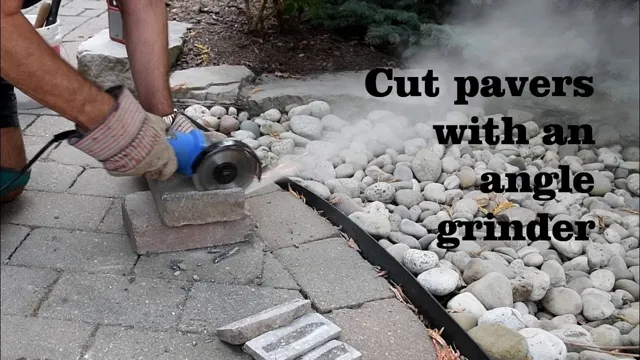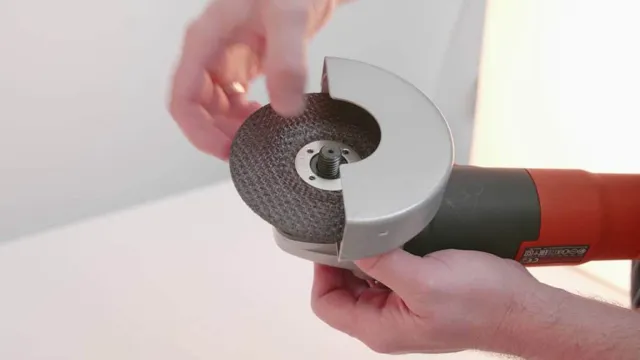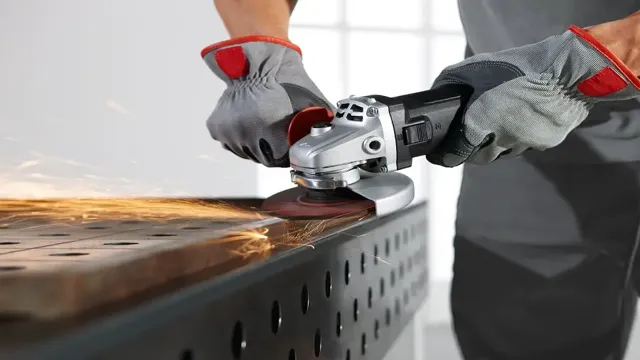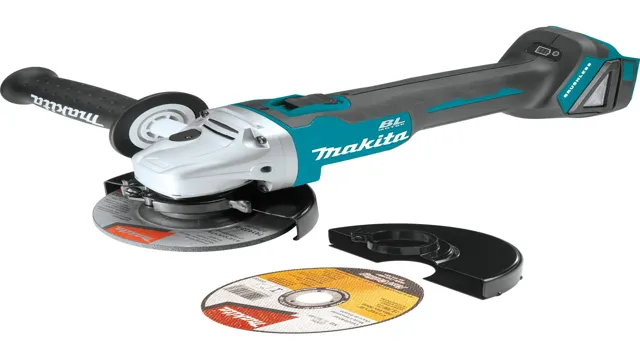How to Cut Pavers with an Angle Grinder: Tips and Tricks for Smooth Cutting Results

If you’re planning a DIY paving project, you may be wondering how to cut pavers with precision and ease. One popular way to achieve this is by using an angle grinder. This handheld power tool is a versatile option that can cut through various materials, including concrete, brick, and stone.
In this how-to guide, we’ll show you the steps on how to cut pavers with an angle grinder. Whether you’re a seasoned DIYer or a beginner, this guide will give you the confidence to tackle your next paving project with ease. So grab your safety gear and let’s get started!
Step 1: Prepare the materials
If you’re wondering how to cut pavers with an angle grinder, the first step is to prepare the materials. You’ll need an angle grinder with a diamond blade, safety gear (gloves, eye/ear protection, dust mask), measuring tape, square, chalk or marker, and of course, the pavers themselves. It’s important to choose the right diamond blade for your angle grinder, so be sure to read the manufacturer’s instructions carefully.
Before you start, make sure the pavers are clean and free from any debris or dirt. Then, use the measuring tape, square, and chalk or marker to mark where you want to cut the pavers. Taking the time to prepare the materials will ensure that your cutting job is more precise and efficient.
Gather necessary items, such as pavers, angle grinder, safety goggles, and earmuffs.
To start with your DIY paving project, the first thing you need to do is gather all the necessary materials. You will need pavers, an angle grinder, safety goggles, and earmuffs. Purchasing quality pavers is essential as they will determine the durability and overall look of your pavement.
Keep in mind the size and thickness of the pavers and the pattern you want to create. You should also wear safety goggles and earmuffs to protect your eyes and ears from flying debris and the loud noise from the angle grinder. Always prioritize safety in any project you undertake.
When gathering your materials, check if you have everything you need before beginning the project to avoid stopping midway through due to shortages. By following this first step, you can ensure that you have all the necessary items to begin your DIY paving project successfully.

Set up a flat work surface with a solid foundation. Ensure there’s enough space around to manoeuvre the angle grinder.
Before you start using an angle grinder, you need to prepare the materials. The first step is to set up a flat work surface with a solid foundation. Make sure it is stable and won’t wobble or move while you’re using the grinder.
You should also ensure that there is enough space around the work surface to manoeuvre the angle grinder comfortably. Once you have a stable work area, you can proceed to gather all the necessary materials, including the angle grinder, abrasive discs, and safety equipment such as gloves, eye protection, and a face shield. Ensure that the discs you’re using are compatible with your grinder and made for the material you’re grinding.
It’s best to check the manufacturer’s instructions for guidance. Once you have everything you need, you can start with confidence, knowing that you’ve created a safe and stable work environment.
Step 2: Choose the right blade
When it comes to cutting pavers with an angle grinder, choosing the right blade is key to achieving a clean and precise cut. There are different types of blades available in the market, each with specific applications and compatibility with different materials. However, for paver cutting, a diamond blade is the most suitable option.
A diamond blade can handle the tough and abrasive nature of pavers and create precise cuts without damaging the material. When choosing a diamond blade, consider the size and thickness of the pavers you will be cutting, as this will determine the size and thickness of the blade needed. Additionally, check for the RPM rating of your angle grinder to ensure it matches the recommended RPM for the blade you plan to use.
By selecting the right blade, you can cut pavers efficiently and safely with an angle grinder.
Choose a suitable diamond blade that can easily cut through the pavers and accommodate the angle grinder.
When it comes to cutting pavers with an angle grinder, choosing the right blade is essential. Diamond blades are the best option for this kind of job because they are designed to slice through hard materials like concrete, brick, and natural stone. However, not all diamond blades are suitable for cutting pavers.
You need to find a blade that can fit easily onto the angle grinder and has the necessary size and shape to cut through your specific type of paver. It’s important to consider the diameter, thickness, and arbor size of the blade before making your purchase. The last thing you want is to risk damaging your pavers or your angle grinder by using an ill-fitting blade that’s either too small or too large.
So, take your time to research and choose the right blade that matches your angle grinder and paver size to make the cutting process easier and safer. Keyword: diamond blade.
The blade should be compatible with the diameter of the angle grinder.
One of the essential parts of choosing the right blade for an angle grinder is to ensure compatibility with the diameter of the tool. The last thing you want is to have a blade that is either too big or too small for your angle grinder as it could lead to disastrous results. You’ll need to take a close look at the manufacturer’s specifications to make sure that you choose a blade that’s made to match the diameter of your grinder.
It’s not uncommon for blades to come in various sizes and shapes, and each blade will work best based on the diameter of your tool. If you’re not sure which blade to choose, make sure to consult with an expert or refer to your user manual for more information. You don’t want to risk ruining your grinder or injuring yourself by using the wrong blade.
By taking this step seriously and choosing the right blade for your angle grinder, you’ll be able to efficiently cut through a variety of materials without any hassle.
Step 3: Put on your safety gear
When cutting pavers with an angle grinder, safety should be your number one priority. Before you begin, make sure to put on your safety gear. This means wearing safety glasses to protect your eyes from flying debris, earplugs to prevent hearing damage from the grinder’s loud noise, and gloves that can provide grip and protection for your hands.
Additionally, wearing appropriate clothing can help prevent accidents. Loose clothing or jewelry should be avoided as they can get caught in the angle grinder’s moving parts. Overall, taking the time to put on your safety gear will create a safer environment for you to work in and ensure that you have a successful and injury-free cutting experience.
So, before you start cutting those pavers, remember to gear up and stay safe!
Wear safety goggles to protect your eyes from flying debris.
When it comes to woodworking or any construction work, safety should always come first. Once you have your work area set up and have all the right tools, the next most important thing is to put on your safety gear. One of the key items that you should always wear is safety goggles.
These essential pieces of equipment protect your eyes from debris or flying objects that could cause serious eye injuries. Whether you’re sawing, drilling, or sanding, safety goggles provide an extra layer of security that ensures you can work with confidence. Not only does wearing safety goggles make sense from a practical perspective, but it’s also a legal requirement on most construction sites.
So if you’re serious about woodworking or construction work, make sure you always have a pair of safety goggles in your toolkit.
If applicable, use ear protection for loud noises the grinder may create.
When it comes to using a grinder, safety should always be your top priority. Before you even turn on the grinder, make sure to put on all the necessary safety gear. This includes eye protection, gloves, and if applicable, ear protection.
The loud noises that the grinder may create can be harmful to your ears, so it is always better to be safe than sorry and use ear protection when necessary. Investing in a good pair of ear protectors is a wise decision that can protect your hearing and prevent damage to your ears. Remember, you only have one set of ears, so taking care of them should be a top priority.
So, put on your safety gear and stay protected while you tackle your grinding project to ensure that you can enjoy all your future DIY projects.
Wear a lung mask to cover your nose and mouth from the dust generated.
When it comes to staying safe on the job, the right gear is crucial. And if you’re working in an environment where dust is a concern, you’ll definitely want to invest in a good quality lung mask. These masks are designed to cover your nose and mouth, protecting your lungs from the harmful dust particles that can be generated while working.
Not only can this dust be irritating to breathe in, but it can also cause serious lung damage over time. So whether you’re working in construction, demolition, or any other industry where dust is a concern, it’s important to wear a lung mask whenever possible. With the right protective gear in place, you can breathe easy and focus on getting the job done.
Remember, safety first!
Step 4: Start cutting
Now that you’re all geared up and ready, how to cut pavers with an angle grinder? It’s actually simpler than you think! Start by testing out your angle grinder by making a small cut on a spare piece of paver. Once you’re comfortable, slowly approach the paver you need to cut and lightly press the angle grinder to its surface. Make sure to keep your hands steady, and move the grinder in a slow, consistent motion along the line you want to cut.
One important thing to remember is to make several passes rather than trying to cut through the entire thickness all at once – this helps to avoid cracking or damaging the paver. Don’t forget to wear safety glasses and earplugs as cutting and grinding can get quite loud. With a bit of practice, you’ll soon master how to cut pavers with an angle grinder like a pro!
Turn on the angle grinder and slowly lower the spinning blade onto the paver you’ll be cutting.
When it comes to cutting pavers, it’s important to start the process with precision and care. This is where an angle grinder comes in, and step four of the cutting process begins. So, take a deep breath and get ready to start cutting.
Turn on the angle grinder and make sure the blade is spinning before slowly lowering it onto the paver. It’s crucial to be gentle and gradual in this process, as being too rough or harsh can cause cracks or unwanted breaks in the paver. Remember, the goal is to have a clean and precise cut, so take your time and ensure that the blade is properly aligned.
Once you’re confident with your positioning, you can continue with the cutting process, taking it one careful slice at a time. With this approach, you’ll be well on your way to creating a beautiful and polished paver for your next at-home project.
Maintain a slow, steady pace that doesn’t overtax the grinder’s motor or the blade.
As you’re about to start cutting with your angle grinder, it’s important to remember to maintain a slow, steady pace. Going too fast can overtax the grinder’s motor, causing it to overheat and potentially fail. It can also cause the blade to wear down much faster, resulting in a shorter lifespan for the tool.
Conversely, going too slow can also cause problems, as it can put unnecessary strain on the blade, leading to duller cuts and a shorter lifespan for the blade itself. So, the key is to find a balance – a pace that’s steady but not too slow or fast. This may take a bit of practice, especially if you’re new to using angle grinders, but with time and experience, you’ll learn to find that sweet spot.
Remember, taking your time and being patient will pay off in the long run, as it will help you create smoother, cleaner cuts that require less effort to achieve.
Repeat these steps if you need to make multiple cuts on the paver.
If you need multiple cuts on your paver, repeat these steps to ensure a clean and precise cut every time. Now, it’s time to start cutting! Turn the saw on and gently bring the blade down onto the paver. Take it slow at first, allowing the blade to work its way through the material.
As you cut, be sure to use both hands to guide the saw and keep it stable. Move the paver forward slowly as you cut through it, continuing until you have made a full pass. Once you have completed the first cut, you can move on to the next one, repeating the same process until you have made all the cuts necessary for your project.
Remember to take your time, and don’t rush the process. With patience and precision, you will achieve a clean and accurate cut every time. So, get cutting and enjoy the satisfaction of a job well done!
Step 5: Finish the job
Now that you have cut your pavers with an angle grinder, it’s time to finish the job. Start by sweeping up any debris or dust that is left over. You can use a broom or a vacuum to make sure you get everything.
Next, it’s time to lay your pavers down. Make sure to lay them in the pattern that you want, leaving a small gap in between each one for sand. Once you have them all laid out, fill the gaps with sand and use a rubber mallet to tamp them down.
This will help ensure that they are all level and secure. Finally, spray your pavers down with water to help settle the sand and create a solid base. With these steps, you’ll have a beautiful new patio or walkway that you can enjoy for years to come!
Once cutting is complete, let the paver pieces settle and avoid touching them until they’re at a safe temperature.
After the paver cutting is complete, it’s important to give the pieces adequate time to settle. You should avoid touching or walking on them until they have cooled down and are at a safe temperature. Once they’ve had time to settle, you can brush sand into the joints to help lock the pavers in place.
This will ensure that they stay in position for years to come. The final step is to give the entire area a thorough cleaning, removing any dust or debris. You can use a leaf blower or a hose to do this.
Once the cleaning is complete, you can sit back and admire your handiwork! It’s important to note that cutting pavers can be a difficult and potentially dangerous process if you’re not experienced. It’s always best to hire a professional if you’re not confident in your abilities. With this in mind, you can be proud of your newly paved patio or driveway and enjoy it for years to come.
Clean up the work area and store the tools safely.
Once the job is complete, it’s important to not leave a mess behind. Take the time to clean up your work area thoroughly. This not only makes the space safer for others to navigate, but it also gives you a chance to inspect your work and ensure that everything has been done to your satisfaction.
Once the area is clean, put your tools away in a safe and secure place. It’s crucial to store them properly to prevent damage or injury. Remember to always keep sharp items out of reach of children and pets.
Overall, finishing a job properly means taking care of all the details, including the cleanup and storage of tools. By doing so, you set yourself up for success the next time you take on a project.
Conclusion
In conclusion, cutting pavers with an angle grinder may seem daunting at first, but with the right tools and techniques, it can be an easy and satisfying DIY project. Remember to wear protective gear, mark your cuts accurately, and take the time to perfect your technique. With a steady hand and a bit of patience, you’ll have perfectly cut pavers that will make your project look like a professional job.
So grab your angle grinder and get cutting – with a little bit of practice, you’ll soon be a paver-cutting pro!”
FAQs
What safety measures should I take before cutting pavers with an angle grinder?
Before cutting pavers with an angle grinder, make sure to wear safety goggles, ear muffs, heavy-duty gloves, and a dust mask. Clear the area of any flammable materials, and keep a fire extinguisher nearby.
What kind of blade should I use to cut pavers with an angle grinder?
You should use a diamond blade that is specifically designed for cutting concrete or pavers. This type of blade will give you the best results and last longer than a regular metal blade.
How do I determine the correct depth for cutting pavers with an angle grinder?
Make a test cut in an inconspicuous area to determine the depth, and adjust the blade depth accordingly. It’s important to avoid cutting too deeply into the pavers, as this may weaken them and cause them to crack.
Can I cut curves or angles into pavers with an angle grinder?
Yes, you can use an angle grinder with a diamond blade to make curves or angles in your pavers. However, this requires a steady hand and a bit of practice to achieve a clean cut.
How do I prevent the angle grinder from overheating during extended use?
Allow the angle grinder to cool down for a few minutes after every 20-30 minutes of use. This will help prevent it from overheating and prolong its lifespan.
Is it better to cut wet or dry when using an angle grinder to cut pavers?
For best results, it is recommended to cut pavers when they are dry. Wet pavers can be more difficult to cut and may cause the blade to slip. However, if you do choose to cut wet pavers, make sure to use a GFCI-protected outlet to prevent electrical shock.
How can I make sure my cuts are straight and accurate when using an angle grinder?
Use a straightedge or chalk line to mark your cut lines, and follow them carefully with the angle grinder. Don’t rush and be sure to maintain a steady hand and a consistent speed for the best results.



